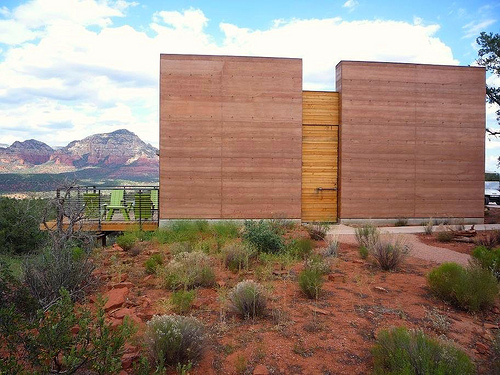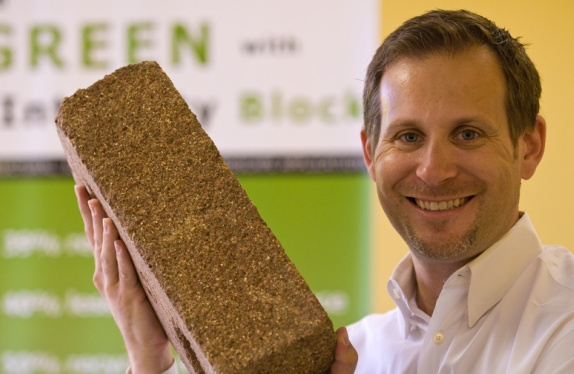Integrity Block
26 January 2010
6,135 views
2 Comments
Concrete Masonry Units, also affectionately called “CMU,” provide those fortunate enough to be able to lay hands on them with an easy, fire-resistant, low maintenance, cheap way to throw a wall together in a hurry. All that’s needed is a foundation, the aforementioned CMU, reinforcement, mortar, concrete to fill the voids in the blocks where necessary, and somebody with a strong back to put it all together. Convince your somebody to stack these ingredients evenly in neat rows – and voila! You have a wall. You can even cover up CMU with something else if they look ugly. So where’s the drawback?
According to the Portland Cement Association, “the standard concrete block is a rectangular 8X8X16-inch unit (200X200X400 mm) made mainly of portland cement, gravel, sand, and water. The concrete mixture may also contain ingredients such as air-entraining agents, coloring pigment, and water repellent” (Source: PCA). While cement is in many ways an exquisite material, it is also energy intensive to produce. It’s also subject to price volatility due to fluctuations in demand, although I read somewhere that right now it’s being consumed by humankind in larger quantities than water.*
One solution to the problem of too much cement in one’s concrete walls is to bulk the mixture up with a large quantity of dirt. Rammed earth construction and adobe are two alternatives that use soil composites and recycled rock materials – often from the very site on which the construction occurs (local is good). This construction technique produces absolutely gorgeous, thick, luscious walls with amazing striations running through them. Of course, the look is a bit “unconventional” and this might make it tricky to finance the construction in say, a pseudo-Victorian duplex development. The other problem with this type of construction is that not every Tom Dick or Harriet knows how to do it.
Image copyright Bilsano
Integrity Blockhas attempted to take the convenient aspects of a unitized masonry construction system and combine them with the earth-friendly, dirt-filled characteristics of rammed earth construction. Integrity Block’s building blocks are made out of a super-secret proprietary soil composite that contains pre-consumer recycled content (waste material from mining and quarrying operations). The manufacturing process consumes 40 percent less energy and emits 39 percent less carbon (Source: Edmonds). While the goal is to cut cement out of the formula for the blocks at some future date, right now there is 40% less cement than in traditional CMU (Source: Schwartz).
Image courtesy Integrity Block
So here are some reasons why Integrity Block has all the makings of awesomeness: the super-secret proprietary soil composite is formulated such that blocks come in earthy colors like brown or gray; the blocks come in standard sizes, and they meet typical CMU performance standards and established codes. Anyone (by which I mean almost everyone) who can lay CMU will be able to work with Integrity Block. I can practically smell the LEED credit.
As far as I can tell, Integrity Block distributes its product only in Northern California, in order to keep the old carbon footprint low, but they’re trying to expand production across the United States (Source: Edmonds). Let me know if you’ve used this product and describe the experience, if you’re inclined.
Image courtesy fastcompany.com
WU XING: EARTH
The large quantity of soil that has crept into these blocks make assigning them to the Earth category something of a no-brainer. I wonder how they would perform in a marine environment – I’m picturing a sea-side marsh in Georgia, for example.
*I can’t properly attribute this statement and you may choose to assume that I made it up.
Cited:
“Concrete Masonry Units.” The Portland Cement Association. Accessed 01/29/10. URL.
Edmonds, Molly. “What’s so Special about Integrity Block?” HowStuffWorks.com. Accessed 01/26/10. URL.
Schwartz, Ariel. “10 Green Startups to Watch” FastCompany.com 11/10/09. Accessed 01/26/10. URL.



















He looks so happy holding that block, they must be great!
Hey, Alli –
You sure did a lot of research and it shows! These alternatives are very interesting. Hope to utilitze some of these materials when we finally buy our home in Sonoma.
Keep on keeping us informed.
Jess
Leave a Wordpress Comment:
Ads
Watch ARCHITERIALS Videos on vimeo
Like on Facebook
Twitter
Flickr
Hit Counter
Ads
Blogs
Green
Journals/Publications
Materials
Network/News
Offices/People
Resources
Science
Pages
Archive
RSS and Email Subscriptions
Tag Cloud
3D 3D printer AB FAB academic acid acrylic actuated matter adaptive adhesive adsorption aerogel air air conditioning alloy aluminum amnh antibacterial antifungal ants april fool's architecture architecture robot artificial skin autonomous aviation awesome bacteria bamboo bananas beer bench bend bending biennale biocomputing biodegradable biodegradeable biomaterials biomimetics biomimicry biominerals biopolymer birds blast blast-resistant block blocks blogs Bloom Box brazil brick bubbles bucky bulk metallic glass butterfly calera canvas carbon carbon fiber carbon nanotubes carpet cars ceiling cellulose cement ceramic chain link chair charcoal charlie sheen chemicals chiller clay cloth cloud cmu coils color color-changing communication compound computer concrete condensation conducting conductive context cool coral cracks crystal cyborg demakersvan design digifab dirt disaster dna dror drywall dutch dynamic EAP earth ecocradle ecolect e coli ecology ecoresin ecovative elastic electric electricity electrochromic electroluminescent electronic energy energy recovery environment evaporative cooling experiment fabric fabrication facade fiber fiberglass fiber optic fiber optics fibers film FIRE flexible flickr fly ash foam fungus furniture garbage gel geodesic dome geometry gfrp gilgamesh glass glass fiber glow glue gold graphene green greensulate gsapp gypsum hard heat heavy heidi klum helix hemp hexagon hidden high performance hive honeybee humidity ice India ink insulation interference Internet inventables invisible invisible ink jello jellyfish just add water kevlar kinetic korea lace lamboo laser lattice leaves LED leed LEGO light light emitting light transmitting liquid lo mein london Loop.pH machines magic magnetic marine material materials meatball melting memory metabolic engineering METAL metal panel metamaterial micro microsensor microtools military milk MIT moisture multi-layer mushrooms mycelium nano nanogel nanotech nanotubes NASA new noise non-metallic oil OLED OMA ostrich oysters packaging paint panel panels paper paperfoam paraffin wax particles particulates petroleum phase change phosphorescent pink PLA plastic platinum pm-10 poetry pollution polymer polymers porcelain power precast printed printing protein public quadror radiant rain rammed earth reclaimed recycled reflective refracting Rem Koolhaas resin robot robotics roof rubber rugged sand sealant sealer search segmented self-healing sensor shape memory silica silicon silk skin skittles slats smog soft solar solar cell solar cells solar paint solid solid state lighting sound spider spider glue spray stabilized sand stone stretch stretchable strong structural structure studio dror sun sunglasses super supercritical sustainable switzerland tags tape technology TED tensile TEXAS textile textiles texture thermal thermochromatic thin thin film thread tiger stone tile tiles timber tio2 tires toaster tokujin yoshioka touch touch-sensitive toxic transparent t shirts tulip ultra-thin university of akron university of connecticut upcycling virus voc wall wallpaper WATER web wet whale wires WOOD woodwool wool workshop
WP Cumulus Flash tag cloud by Roy Tanck and Luke Morton requires Flash Player 9 or better.
Recent Comments
Ads